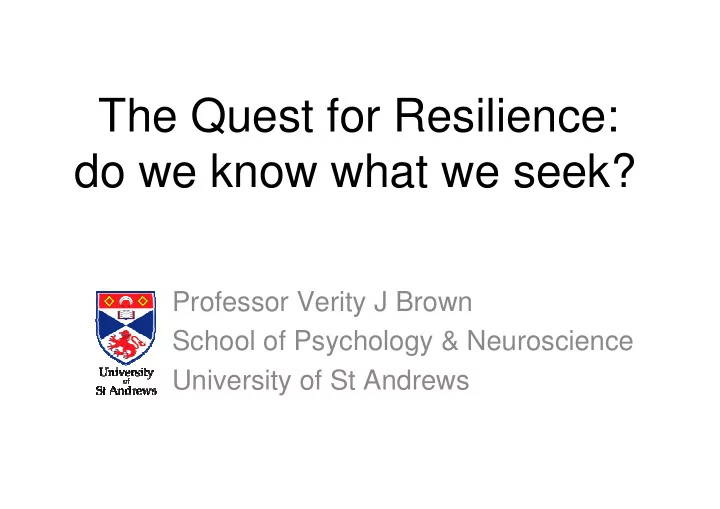

The Quest for Resilience: do we know what we seek? Professor Verity J Brown School of Psychology & Neuroscience University of St Andrews
What is resilience? How do you get it? How do you know when you have it?
Physical resilience “Resilience is the ability of a material to absorb energy when it is deformed elastically, and release that energy upon unloading. The modulus of resilience is defined as the maximum energy that can be absorbed per unit volume without creating a permanent distortion”. http://en.wikipedia.org/wiki/Resilience, DoD 29.08.2012
http://rido-resilience.blogspot.co.uk/2010/07/building-blocks-to-being-resilient.html
“resilience is more than merely returning to a previous state, it includes the capacity of people and communities to learn and/or to recognise and benefit from the new possibilities that change brings”. Paton D (2006) Disaster resilience: integrating individual, community, institutional and environmental perspectives In: Paton, D & D Johnson (Eds.) Disaster resilience: an integrated approach
Resilience is a set of actions and attitudes that prepare individuals and groups for adapting to challenging situations; establishing a “new normal;” and realizing one’s potential for growth. http://www.dcoe.health.mil/HowWeDoIt.aspx
“Resilience is a flexible concept that can provide the guiding principles to managing a risky, uncertain environment. Nonetheless, challenges remain. Adopting this concept requires a coordinated and mindful process combined with strong leadership” http://www.css.ethz.ch/publications/pdfs/CSS-Analyses-60.pdf
Psychological resilience Psychological resilience means not merely surviving, but thriving . It is far more than “bouncing back”, or even “coping well”: positive change comes from adversity
Manteo Mitchell
Is it a bird? Is it a plane?
"Failure can happen to anyone, and pupils need to cope and learn from it. The most successful entrepreneurs often failed many times, but it didn't stop their drive." Stephen Twigg MP, Labour's Shadow Education Secretary. Credit: Press Association
http://images.mirror.co.uk/upl/m4/aug2011/9/5/maurice-reeves-of-reeves-furniture-store-in-croydon-surrey-talks-to-reporters-outside-his- destroyed-showroom-pic-pa-556503777.jpg
Was uns nicht umbringt, macht uns stärker That which does not kill us, makes us stronger Friedrich Nietzsche by Edvard Munch, 1906 (Wikipedia)
“This platitude serves to ease the discomfort of the observer. It can only rightly be said by those who have been strengthened, and it can only rightly be said about themselves, not to others. The truth is that some people never get into the second group. Those who do get there experience considerable weakness before strength develops.” - Diana Hartman http://blogcritics.org/culture/article/lifes-lies-that-which-does-not/page-1/
What is resilience? “Resilience is a flexible concept… How do you get it? [which]…requires a coordinated and mindful process combined with strong leadership” How do you know when you have it?
Will the organisation survive a catastrophe?
25 ITEM RATING SCALE http://www.cd-risc.com/index.shtml Vaishnavi, Connor and Davidson (2007) An abbreviated version of the Connor-Davidson Resilience Scale (CD-RISC), the CD-RISC2 Psychiatry Research 152: 293–297
� TWO ITEMS ONLY: 1. Tend to bounce back after illness or hardship 2. Able to adapt to change “…the CD-RISC2 assesses the characteristics of resilience, but does not assess the resiliency process or provide information about theories of resilience” Vaishnavi, Connor and Davidson (2007)
PROTECTION PROTECTION RECOVERY RECOVERY RESPONSE RESPONSE PREPAREDNESS
Anticipating threats (‘protection’) and having procedures and rules (‘preparedness’) for dealing with them effectively (‘response’) means that problem-solving resources are available for building capacity (‘recovery’)
Reduce vulnerability PROTECTION PROTECTION PREPAREDNESS RESPONSE RESPONSE RECOVERY RECOVERY Increase flexibility
How can an organisation increase its flexibility?
Rats are trained to find food in the black (or white) arm of a maze. Once they are reliably choosing the correct arm, some are given additional training trials. Then the rule is “reversed” and the food is now Reid (1953) in the other arm
Rats who are ‘over-trained’ learn the reversed rule in half the number of trials 160 140 120 100 Number of trials to learn 80 the reversal 60 40 20 0 0 50 150 Reid (1953) Number of additional training trials
Far from getting ‘set in their ways’ by repetition, animals (learners) become more flexible with experience This is because the first order rule (“choose BLACK”) is learned first and then the second order rule (“focus on the colour”) is learned. Organizations should promote the learning of second-order rules because this leads to flexibility
Resilience is a flexible concept, but flexible to the point of floppy is not very useful However, the concept has been useful: attention has moved from how to respond to external factors (i.e., reactive risk management) to how to develop an internal resource (proactive identification of strategic systems)
Recommend
More recommend